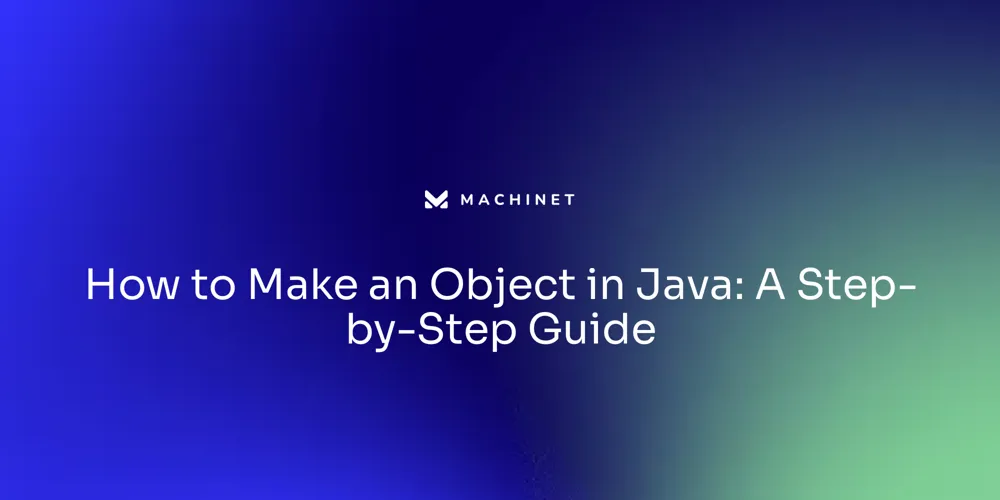
Table of Contents
- Understanding Classes and Objects
- Step 1: Define a Class
- Step 2: Declare an Object Variable
- Step 3: Create an Object
Introduction
Java's object-oriented programming (OOP) paradigm revolves around classes and objects. A class serves as a blueprint for creating objects, each with its own unique state and behavior.
In this article, we will explore the process of defining classes, declaring object variables, and creating objects in Java. By understanding these fundamental concepts, developers can harness the power of Java's modern features and build efficient, scalable, and maintainable software systems. So let's dive into the world of classes and objects in Java and discover how they enable us to model real-world scenarios and solve complex problems.
Understanding Classes and Objects
Java's object-oriented programming (OOP) paradigm is centered around classes and objects. A class in Java is akin to a blueprint—it outlines the structure and capabilities of objects that can be created from it.
These objects are tangible representations of the class, each with a unique state and set of behaviors. For instance, consider a class as a template for a building, complete with definitions for various sections such as rooms and hallways.
Similarly, a Java class contains properties and methods—properties define the state, akin to the characteristics of a room, while methods are akin to the actions that can occur within a space. Creating an object in Java is a fundamental skill, akin to constructing a building from its blueprint.
The process involves defining a class with a specific name and potentially inheriting attributes from a superclass. Within this class, instance variables represent the object's properties, and methods encapsulate the tasks it can perform.
This encapsulation is a core aspect of OOP, aiming to model real-world scenarios through concepts like inheritance, abstraction, and polymorphism. Consider the practical application of these concepts in a simple command-line parking lot system.
In this scenario, objects represent various elements of the system, such as parking spots or vehicles, each with its own data and behavior. By understanding the latest features in Java, like JDK 21's virtual threads and generational Z garbage collector, or the preview of primitive types in patterns introduced in JDK 23, developers can write more efficient and readable code. This knowledge not only helps in managing complexity but also in building scalable and maintainable software systems. Oracle's six-month release cycle ensures that Java remains updated with the latest advancements. As Java evolves, features like the Vector API and the Stream Gatherers provide developers with powerful tools to express vector computations and enhance performance across different CPU architectures. Understanding these modern features allows for the creation of sophisticated, real-world applications that align with how humans naturally think about and solve problems.
Step 1: Define a Class
In Java, the journey of creating an application begins with defining a class using the 'class' keyword. A class serves as a blueprint for objects and encapsulates data for the object and methods to manipulate that data. For instance, in a simple parking lot system application, you'd start by outlining the requirements, such as a parking lot ID, floors, and slots for different vehicle types like cars, bikes, and trucks.
Each class is stored in its source file, with the file name matching the class name, following Java's naming conventions and enabling better organization and readability. As Java has evolved to become more user-friendly, new features like automatic compilation and the 'var' keyword have simplified the language, making it less intimidating for beginners. The 'var' keyword allows developers to declare a variable without specifying its type, which the compiler infers from the context.
This feature is part of Java's efforts to streamline development without compromising its strong typing principles. Memory management in Java is a crucial aspect that affects performance. The Java Virtual Machine (JVM) handles this automatically, using a stack for local variables and method parameters and a heap for dynamic memory allocation, such as when creating objects.
Understanding how classes and objects interact with memory is essential for optimizing system performance. When defining classes, it's important to follow best practices like using meaningful names and avoiding abbreviations that could cause confusion. This attention to detail promotes code readability and maintainability, allowing you and others to understand and work with your code efficiently.
Step 2: Declare an Object Variable
In Java, when you define a class, you're essentially creating a blueprint for objects that share common characteristics—attributes represented by instance variables and behaviors encapsulated within methods. To utilize this blueprint and bring an object to life, you must declare a variable of the class type, which serves as a handle or a reference to the object itself. This reference is your gateway to accessing the object's methods and properties, enabling you to interact with the object and instruct it to perform tasks.
For instance, consider a Car class that includes attributes like color and speed. After defining the class, you would declare a variable, say my Car, of the type Car. This variable doesn't contain the object itself but rather points to where the object exists in memory.
Through my Car, you can set properties like my Car.color and invoke methods to manipulate the car's behavior. This distinction between primitive data types, which store actual values, and reference data types, which store the address of the object, is fundamental to Java's strong typing system, ensuring that each variable is explicitly declared and operates within its defined scope. As Java evolves, with JDK 21 introducing features like pattern matching in switch blocks, it's clear that understanding these core concepts is vital for developers to write clean, efficient, and modern Java code.
Step 3: Create an Object
In the realm of Java, creating an object is a fundamental task, akin to crafting a unique entity in a digital universe. It begins with the 'new' keyword, a powerful incantation that conjures memory space for the object. Followed by the class name, akin to specifying the blueprint, and a pair of parentheses, this ritual breathes initial life into the object, setting its state in the vast landscape of Java applications.
From its inception nearly three decades ago as 'Oak', Java has evolved into a titan of the software world, influencing everything from diminutive IoT devices to colossal server infrastructures. This evolution has been marked by the addition of numerous features, each carefully integrated to maintain the essence of Java while propelling it into the future. One such feature, the checked exception, stands out as a testament to Java's unique approach to error handling—despite the mixed feelings it garners among developers.
Today, Java retains its vigor by offering unmatched flexibility and control. Developers are granted the autonomy to mold their applications with precision, harnessing the full might of Java's standard libraries. This adaptability proves invaluable when tackling complex projects that defy cookie-cutter solutions.
Moreover, Java's robust ecosystem is continually enriched by frameworks and libraries that streamline development, as evidenced by the extensive resources available in the latest Java documentation. This rich tapestry of Java's history and capabilities is not just theoretical; it is woven into the practical fabric of every object instantiated. As developers navigate through Java's syntax and semantics, they are participating in a legacy that spans decades and will likely continue to thrive in the software domain for years to come.

Conclusion
Java's object-oriented programming (OOP) paradigm revolves around classes and objects. A class serves as a blueprint for creating objects, each with its own unique state and behavior.
We explored the process of defining classes, declaring object variables, and creating objects in Java. Defining a class involves using the "class" keyword to outline properties and methods.
By following best practices, developers promote code readability and maintainability. When declaring an object variable, we create a reference to access methods and properties, enabling interaction and behavior manipulation.
Creating an object in Java involves using the "new" keyword followed by the class name to allocate memory space. By harnessing modern features like virtual threads or primitive types in patterns, developers can write more efficient and readable code. Understanding classes and objects is crucial for building efficient, scalable, and maintainable software systems. By following best practices, utilizing modern features, and embracing Java's rich history, developers unlock their full potential in solving complex problems. Let's continue exploring the world of classes and objects in Java with confidence and creativity.
AI agent for developers
Boost your productivity with Mate. Easily connect your project, generate code, and debug smarter - all powered by AI.
Do you want to solve problems like this faster? Download Mate for free now.




